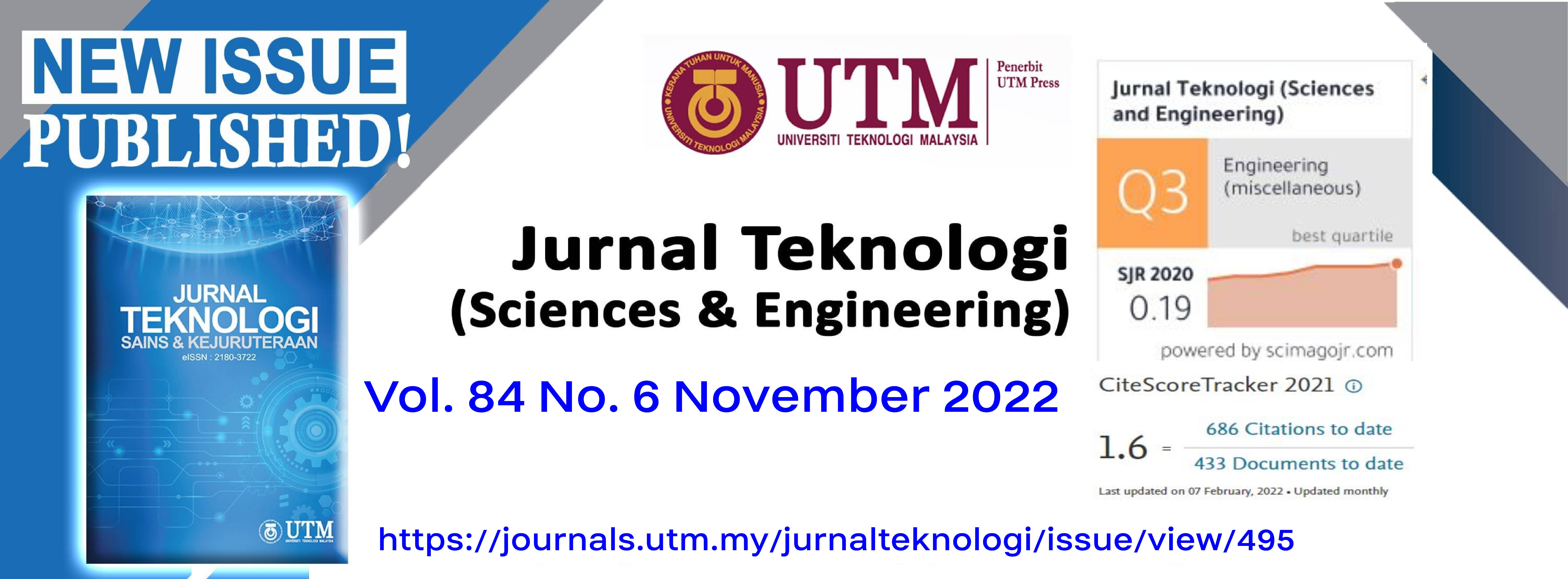APPLICATION OF TAGUCHI METHOD TO OPTIMIZE ULTRASONIC VIBRATION ASSISTED FUSED DEPOSITION MODELING PROCESS PARAMETERS FOR SURFACE ROUGHNESS
DOI:
https://doi.org/10.11113/jurnalteknologi.v84.18431Keywords:
Ultrasonic vibration, surface roughness, Taguchi method, ANOVA, FDMAbstract
This paper presents the findings on the process parameters for surface roughness optimization of an open-source ultrasonic vibration assisted fused deposition modeling (FDM) printed specimen. Acrylonitrile Butadiene Styrene (ABS) material for the specimens and the printing temperature, layer thickness, and surface layer were determined as the control parameters that influenced the surface roughness. Experimental design with Taguchi level 9 (3*3) Orthogonal Arrays (OA) was designed with nine experimental runs. Three levels of each control factor was identified. In addition, data for multi-responses of build time and surface roughness was obtained by utilizing and conducting the nine-requirement experimental run for Taguchi Method. The specimens were printed using an open-source ultrasonic vibration assisted FDM printer with a 20kHz ultrasonic vibration supplied to the printing platform of the printer. Analysis of variance (ANOVA) was conducted to determine whether p-values are significant with the model or otherwise. The experiments examined the build time and surface roughness, the responses were collected and optimized by using the grey relational grade (GRG). The result shows no correlation between build time and surface roughness in the grey relational grade, and the p-value was higher than 0.05 significant level. However, the surface roughness for optimal level combination setting showed the obvious result, which the settings consist of printing temperature (level 1), layer thickness (level 1), and surface layer (level 1).
References
Sheridan, L., J. E. Gockel, and O. E. Scott-Emuakpor. 2021. Stress-defect-life Interactions of Fatigued Additively Manufactured Alloy 718. Int. J. Fatigue. 143(August): 106033.
Zhu, J., H. Zhou, C. Wang, and L. Zhou. 2020. A Review of Topology Optimization for Additive Manufacturing: Status and Challenges. Chinese J. Aeronaut. October: 20.
Marmarelis, M. G.and R. G. Ghanem. 2020. Data-driven Stochastic Optimization on Manifolds for Additive Manufacturing. Comput. Mater. Sci. 181(March): 109750.
Yadav, D. K., R. Srivastava, and S. Dev. 2019. Design & Fabrication of ABS Part by FDM for Automobile Application. Mater. Today Proc. 26: 2089-2093.
Daminabo, S. C., S. Goel, S. A. Grammatikos, H. Y. Nezhad, and V. K. Thakur. 2020. Fused Deposition Modeling-based Additive Manufacturing (3D printing): Techniques for Polymer Material Systems. Mater. Today Chem. 16: 100248.
Eswaran, P., K. Sivakumar, and M. Subramaniyan. 2018. Minimizing Error on Circularity of FDM Manufactured Part. Mater. Today Proc. 5(2): 6675-6683.
Huda, A. H. N. F., H. Ascroft, and S. Barnes. 2016. Machinability Study of Ultrasonic Assisted Machining (UAM) of Carbon Fibre Reinforced Plastic (CFRP) with Multifaceted Tool. Procedia CIRP. 46: 488-491.
Yang, C. H., N. Jeyaprakash, and C. K. Chan. 2020. Inhomogeneous Mechanical Properties in Additively Manufactured Parts Characterized by Nondestructive Laser Ultrasound Technique. NDT E Int. 116(August): 102340.
Maidin, S., M. K. Muhamad, and E. Pei. 2015. Feasibility Study of Ultrasonic Frequency Application on FDM to Improve Parts Surface Finish. J. Teknol. 77(32): 27-35.
Panda, A., A. K. Sahoo, and A. K. Rout. 2016. Multi-attribute Decision Making Parametric Optimization and Modeling in Hard Turning using Ceramic Insert through Grey Relational Analysis: A Case Study. Decis. Sci. Lett. 5(4): 581-592.
Rajendra B., and D. Deepak. 2016. Optimization of Process Parameters for Increasing Material Removal Rate for Turning Al6061 Using S/N Ratio. Procedia Technol. 24: 399-405.
Meel R., V. Singh, P. Katyal, and M. Gupta. 2021. Optimization of Process Parameters of Micro-EDD/EDM for Magnesium Alloy using Taguchi based GRA and TOPSIS Method. Mater. Today Proc. 2: 1-7.
Singh G., S. Singh, D. Parkash, V. Gulati, and T. Kaur. 2018. Optimization of EN24 Steel on EDM Machine using Taguchi & ANOVA Technique. Mater. Today Proc. 5(14): 27974-27981.
Chakrapani P.and T. S. A. Suryakumari. 2021. Modelling and Analysing the Water Jet Machining Parameters of Aluminium Nano Composite by ANOVA and Taguchi. Mater. Today Proc. 3.
Marini F., and B. Walczak. 2020. ANOVA-Target Projection (ANOVA-TP). 2nd ed. Elsevier Inc.
Vishwanatha J. S., A. M. Hebbale, N. Kumar, M. S. Srinath, and R. I. Badiger. 2021. ANOVA Studies and Control Factors Effect Analysis of Cobalt Based Microwave Clad. Mater. Today Proc. 46: 2409-2413.
A. Dey and N. Yodo. 2019. A Systematic Survey of FDM Process Parameter Optimization and Their Influence on Part Characteristics. J. Manuf. Mater. Process. 3(3).
Griffiths P. and J. Needleman. 2019. Statistical Significance Testing and p-values: Defending the Indefensible? A Discussion Paper And Position Statement. Int. J. Nurs. Stud. 99: 1-5.
Mohsin I., K. He, Z. Li, F. Zhang, and R. Du. 2020. Optimization of the Polishing Efficiency and Torque by using Taguchi Method and ANOVA in Robotic Polishing. Appl. Sci. 10(3).
Kim N. P., D. Cho, and M. Zielewski. 2019. Optimization of 3D Printing Parameters of Screw Type Extrusion (STE) for Ceramics using the Taguchi Method. Ceram. Int. 45(2): 2351-2360.
Chen X., and S. K. Sarkar. 2020. On Benjamini–Hochberg Procedure Applied to Mid p-values. J. Stat. Plan. Inference. 205: 34-45.
Garamszegi L. Z., and P. De Villemereuil. 2017. Perturbations on the Uniform Distribution of p-values Can Lead to Misleading Inferences from Null- hypothesis Testing. Trends Neurosci. Educ. 8-9(July): 18-27.
Sylajakumari P. A., R. Ramakrishnasamy, and G. Palaniappan. 2018. Taguchi Grey Relational Analysis for Multi-response Optimization of Wear in Co-continuous Composite. Materials (Basel). 11(9): 1-17.
Downloads
Published
Issue
Section
License
Copyright of articles that appear in Jurnal Teknologi belongs exclusively to Penerbit Universiti Teknologi Malaysia (Penerbit UTM Press). This copyright covers the rights to reproduce the article, including reprints, electronic reproductions, or any other reproductions of similar nature.
















